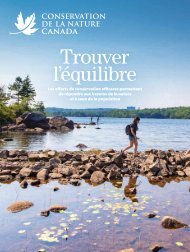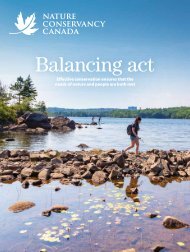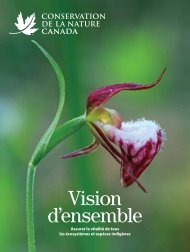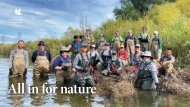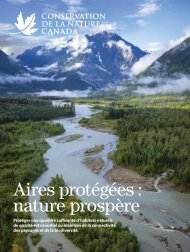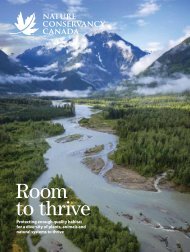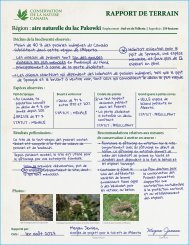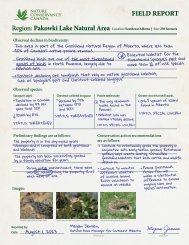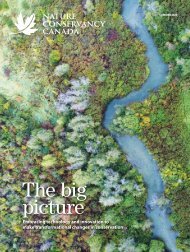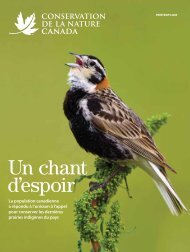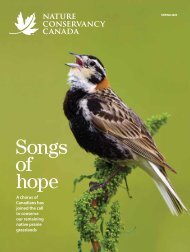NCC Magazine Spring 2024
You also want an ePaper? Increase the reach of your titles
YUMPU automatically turns print PDFs into web optimized ePapers that Google loves.
Through<br />
and through<br />
TKTKTKTKTKTKT<br />
Ensuring every natural system<br />
and native species can thrive<br />
natureconservancy.ca<br />
WINTER 2021 1
SPRING <strong>2024</strong><br />
CONTENTS<br />
Nature Conservancy of Canada<br />
4 What’s in a name?<br />
Migrating birds will soon be returning<br />
to Canadian skies. Let’s pause and think<br />
about what their names mean.<br />
6 St. Peters Harbour and<br />
Lake Run<br />
The crashing of ocean waves and<br />
refreshing breezes brings a calm and<br />
peaceful feeling.<br />
7 A spring swell<br />
The sounds of familiar chirps and buzzes<br />
are a sign of spring and a reminder to join<br />
the Small Acts of Conservation challenge.<br />
7 Empowered by nature<br />
Jessica Burylo flourishes as her full, autistic<br />
self when spending time outdoors.<br />
8 Present and accounted for<br />
Conserving areas of biodiversity that are<br />
representative of landscapes and species<br />
not yet protected is essential to creating<br />
resilient ecosystems.<br />
12 The beaver<br />
Canada’s quintessential aquatic engineer<br />
and wetland builder.<br />
14 Project updates<br />
Protecting coastal habitat in BC;<br />
conserving a key migratory bird rest<br />
stop in Saskatchewan; a conservation<br />
partnership in Nova Scotia.<br />
16 Common ground<br />
Margaret Rosling brings Indigenous<br />
interests and conservation together.<br />
18 Prairie ABCs<br />
An art project weaving together<br />
Maritime tradition with the<br />
Prairie landscape.<br />
Digital extras<br />
Check out our online magazine with<br />
additional content to supplement this issue,<br />
at nccmagazine.ca.<br />
Nature Conservancy of Canada<br />
365 Bloor Street East, Suite 1501<br />
Toronto, Ontario, Canada M4W 3L4<br />
magazine@natureconservancy.ca | Phone: 416.932.3202 | Toll-free: 877.231.3552<br />
The Nature Conservancy of Canada (<strong>NCC</strong>) is the country’s unifying force for nature. We seek<br />
solutions to the twin crises of rapid biodiversity loss and climate change through large-scale,<br />
permanent land conservation. <strong>NCC</strong> is a registered charity. With nature, we build a thriving world.<br />
The Nature Conservancy of Canada <strong>Magazine</strong> is distributed to donors and supporters of <strong>NCC</strong>.<br />
TM<br />
Trademarks owned by the Nature Conservancy of Canada.<br />
FSC® is not responsible for any calculations<br />
on saving resources by choosing this paper.<br />
Printed in Canada with vegetable-based inks by Warrens Waterless Printing.<br />
This publication saved 29 trees and 28,827 litres of water*.<br />
CREATED BY: CALCULATEUR.ROLLANDINC.COM. PHOTO: JENNA RACHELLE. COVER: DANITA DELIMONT/ALAMY STOCK PHOTO (RAM’S-HEAD LADY’S-SLIPPER).<br />
*<br />
2 SPRING <strong>2024</strong> natureconservancy.ca
St. Peters Harbour<br />
and Lake Run, PEI.<br />
Featured<br />
Contributors<br />
MARIE-MICHELE ROUSSEAU-CLAIR: ETIENNE BOISVERT; CHELSEA PETERS: SOUNDS LIKE YELLOW PHOTOGRAPHY; ZACK METCALFE: ZACK METCALFE.<br />
Dear friends,<br />
Where I live and work in Quebec, it gives me great joy to<br />
see northern cardinals outside my office window. This<br />
native songbird reminds me of the role that familiar<br />
animals and plants play in our ecosystems. We often think of common<br />
species as well represented or not in need of protection. Or, we may<br />
think that species should be rare to be protected. But consider the<br />
flip side of the coin: even the most common species need adequate<br />
habitats to prevent them from becoming at risk.<br />
Take, for instance, beavers: an iconic species quintessential to<br />
engineering waterways and maintaining wetlands across the landscape.<br />
As you’ll read about on page 12, beavers may be a common<br />
species, but wetlands, which are underrepresented, need to be<br />
conserved for this species to continue to thrive.<br />
In this issue of the Nature Conservancy of Canada <strong>Magazine</strong>,<br />
we delve into the R of the CARE principle (Connected, Adequate,<br />
Representative and Effective). Simply put, representative means<br />
ensuring that every natural feature, from rivers to Great Lakes,<br />
grasslands to coastal ecosystems, and native species can persist<br />
through time despite changes that cause the biodiversity crisis.<br />
I hope you will be inspired by the stories in this issue that embrace<br />
representation in all its forms, and how it contributes to creating<br />
more resilient landscapes. Thank you for your continued support of<br />
Canada’s nature.<br />
Yours in conservation,<br />
Marie-Michele Rousseau-Clair<br />
Marie-Michele Rousseau-Clair<br />
Chief conservation officer<br />
Zack Metcalfe is a<br />
freelance journalist<br />
and author based in<br />
Salmon Arm, British<br />
Columbia. He wrote<br />
“Present and accounted<br />
for,” on page 8.<br />
Chelsea Peters,<br />
a freelance illustrator<br />
since 2015, resides<br />
in Dundas, Ontario.<br />
She enjoys capturing<br />
nature’s beauty<br />
through line and<br />
watercolour, and aims<br />
to inform and inspire<br />
viewers with her work.<br />
She illustrated “What’s<br />
in a name?” on page 5,<br />
and “Common<br />
ground,” on page 16.<br />
natureconservancy.ca<br />
SPRING <strong>2024</strong> 3
COAST TO<br />
COAST<br />
Henslow’s sparrow’s song, which<br />
resembles a hiccup, is the shortest<br />
and least complex among North<br />
American songbirds.<br />
What’s in a name?<br />
Migrating birds will soon be returning to Canadian skies.<br />
Let’s pause and think about what their names mean.<br />
Learning the name of something is often an important<br />
first step in people engaging with the natural world,<br />
and it can lead to lifelong hobbies involving list-keeping,<br />
sketching, photographing and making sound recordings.<br />
Knowing a name can be the starting point for appreciating<br />
and understanding the species around us. However, what<br />
is in a species’ name, and what it tells us, is quite variable,<br />
even when naming birds. Some birds have quite useful,<br />
descriptive names. Take, for example, red-winged blackbird<br />
and yellow-rumped warbler; in these cases, the bird’s<br />
English common name is descriptive and includes some<br />
identifying features.<br />
However, in other cases, such as Wilson’s warbler or<br />
Townsend’s solitaire, some birds have been named after people<br />
(or “eponymously”). In general, these eponymous names<br />
tell us nothing about the species, and more about the process<br />
of their “discovery” by western science. In some cases, the<br />
people that the birds have been named after are today understood<br />
to be symbols of slavery, colonialism and racism.<br />
Recently, the American Ornithological Society (AOS) decided<br />
to rename birds named eponymously or that are currently<br />
named using offensive or derogatory terms. Although this is<br />
not the case for all historical figures in the case of bird names,<br />
the AOS felt that defining what is and is not acceptable in this<br />
manner was too fraught with difficulty and opted, instead, for<br />
the more straightforward process of renaming all birds that are<br />
named after people.<br />
The effort has also been heralded as a great way to better<br />
reflect birds’ appearance, behaviour or habitat needs, essentially<br />
giving birds names that celebrate them for what they are.<br />
Renaming birds may also remove a barrier felt by people who<br />
have suffered from Western colonialism, hopefully going some<br />
way toward making birds, birding and the natural world more<br />
accessible and a safer place for individuals and communities<br />
who have suffered under systemic exclusion and racism.<br />
Soon, spring migrants will be returning to Canada’s skies.<br />
As we await their return, here are some of our suggestions for<br />
possible new names.<br />
SATHEESH RAJH RAJAGOPALAN/ALAMY STOCK PHOTO.<br />
4 SPRING <strong>2024</strong> natureconservancy.ca
Townsend’s solitaire<br />
Townsend’s solitaire is a type of thrush, but often<br />
perches in conspicuous spots like a flycatcher. It<br />
sings in the winter, likely to defend valuable patches<br />
of juniper berries, which it eats. Some winter in<br />
lowland areas, including in cities such as Calgary.<br />
Baird’s sparrow<br />
This medium-sized, relatively short-tailed sparrow<br />
has yellow and brown streaks down its neck, wings<br />
and back. It spends most of its time on the ground,<br />
foraging for insects and seeds.<br />
Sprague’s pipit<br />
An unassuming, sparrow-sized bird with streaked<br />
brown plumage and an extraordinary flight and<br />
song. In spring, males perform aerial displays with<br />
downward spiral glides over their territory. It is<br />
well-camouflaged among prairie plants.<br />
Potential new name: juniper solitaire<br />
Where to see it: <strong>NCC</strong>’s Lusicich property in the<br />
Castle-Crowsnest Watershed<br />
Potential new name: mixed-grass sparrow<br />
Where to see it: Many locations across Saskatchewan,<br />
including <strong>NCC</strong>’s Wideview Complex property,<br />
in the ecologically significant Milk River Basin area<br />
Potential new name: prairie pipit<br />
Where to see it: McIntyre Ranch in Alberta and<br />
<strong>NCC</strong>’s Old Man on His Back Prairie and Heritage<br />
Conservation Area in Saskatchewan<br />
Bicknell’s thrush<br />
A rare, range-restricted, at-risk species that nests<br />
in dense, high-elevation balsam fir forests. In Nova<br />
Scotia, it occurs in bogs and barrens as well as low,<br />
windswept black spruce and balsam fir, in northern<br />
Cape Breton Island.<br />
Wilson’s snipe<br />
The marsh-dwelling bird hides in dense vegetation,<br />
bursting into the air when disturbed, with<br />
a distinctive “sniiiiipe” call and zigzag flight. Males<br />
display with unique tail feathers, creating an eerie,<br />
“winnowing” sound.<br />
Lincoln’s sparrow<br />
This sparrow species features a yellowy-brown<br />
chest, small bill and very thin stripes on its chest. It<br />
lives in wet, shrubby areas and nests on or near the<br />
ground. It has a lovely, warbler-like song, which<br />
helps with identifying it when it is hidden in brush.<br />
Potential new name: bog thrush<br />
Where to see it: Cape Breton Island’s northern<br />
peninsula, Nova Scotia<br />
Potential new name: dainty marsh-hen or dainty<br />
snipe, after its scientific name “delicata”<br />
Where to see it: <strong>NCC</strong> properties in Nova Scotia,<br />
including Black River Bog<br />
Potential new name: warbling sparrow<br />
Where to see it: <strong>NCC</strong>’s Kingsboro Forest<br />
Nature Reserve on Prince Edward Island<br />
Nelson’s sparrow<br />
Commonly seen hopping among coastal salt<br />
marsh grasses on the East Coast in the summer. Its<br />
characteristic “hissing” call sounds like a drop of<br />
water hitting a hot pan. The rusty orange on its face<br />
and neck makes it stand out from other sparrows.<br />
Bonaparte’s gull<br />
This small, tern-like gull has an elegant, buoyant<br />
flight. In fact, it was initially classified as a tern,<br />
before being assigned as a gull. It is unusual among<br />
gulls in that it nests in trees, in the boreal zone<br />
across northern Canada.<br />
Barrow’s goldeneye<br />
The eastern population of this species is at risk and<br />
inhabits small pockets of land along the Atlantic<br />
coast. This stocky diving duck with yellow eyes nests<br />
in tree cavities near shallow freshwater lakes. Its rapid<br />
wingbeats allow it to fly through dense forests.<br />
CHELSEA PETERS.<br />
Potential new name: marsh sparrow<br />
Where to see it: <strong>NCC</strong>’s Haldimand River<br />
Nature Reserve on Prince Edward Island<br />
Potential new name: boreal forest gull<br />
Where to see it: Abundant in summer along<br />
the Northumberland Strait, such as the Baie<br />
Verte Nature Reserve in New Brunswick<br />
Potential new name: crescent-faced goldeneye<br />
Where to see it: Northern Peninsula of Newfoundland<br />
and southern Labrador<br />
natureconservancy.ca<br />
SPRING <strong>2024</strong> 5
BOOTS ON<br />
THE TRAIL<br />
Gulf of St. Lawrence<br />
★<br />
<strong>NCC</strong><br />
★<br />
<strong>NCC</strong><br />
St. Peters<br />
Lake<br />
<br />
N<br />
St. Peters Harbour<br />
and Lake Run<br />
The crashing waves and refreshing breezes bring a calm and<br />
peaceful feeling to this slice of the Prince Edward Island shoreline<br />
On the northeastern shore of Prince<br />
Edward Island, along the Gulf of<br />
St. Lawrence, lies the Nature Conservancy<br />
of Canada’s (<strong>NCC</strong>’s) St. Peters Harbour<br />
and Lake Run Nature Reserve. Divided<br />
by a tidal channel, the reserve is accessed by<br />
two separate entrance points. Rejuvenate<br />
your mind and body with a stroll along the<br />
beach, which is nestled between the open<br />
ocean and extensive dune landscape. Take a<br />
dip in the ocean while admiring the majestic,<br />
grass-covered dunes.<br />
This seaside gem is popular during the<br />
summer but equally interesting to explore<br />
year-round, especially in spring and fall<br />
when the surroundings are heightened by<br />
the atmospheric conditions. Be on the<br />
lookout for seabirds, rare plants and<br />
aquatic species along the beach, wetlands<br />
and coastal ponds.<br />
TREAD LIGHTLY AND ADMIRE FROM<br />
A DISTANCE<br />
This coastal habitat is located within<br />
a designated Important Bird Area. Stick to<br />
the water’s edge and always keep your pets<br />
on-leash, as their presence might disturb<br />
piping plovers nesting on the beach. Please<br />
keep a distance from the dunes and avoid<br />
walking on them. These fragile habitats serve<br />
as a buffer against the impacts of ocean<br />
storms and protect the inland. Leave no trace<br />
behind and pack out any trash.1<br />
LEARN MORE<br />
natureconservancy.ca/st-peters-harbour<br />
SPECIES TO SPOT<br />
• bald eagle<br />
• beach pea<br />
• black-bellied<br />
plover<br />
• common tern<br />
• great blue heron<br />
• greater<br />
yellowlegs<br />
• mummichog<br />
(in the channel)<br />
LEGEND<br />
Access points<br />
— Beach walk<br />
• Nelson’s sparrow<br />
• northern bayberry<br />
• osprey<br />
• piping plover<br />
• ruddy turnstone<br />
• sanderling<br />
• seabeach<br />
sandwort<br />
• semipalmated<br />
sandpiper<br />
TOP TO BOTTOM: MIKE DEMBECK; MIKE DEMBECK; <strong>NCC</strong>. MAP: PHILINA CHAN.<br />
6 SPRING <strong>2024</strong><br />
natureconservancy.ca
ACTIVITY<br />
CORNER<br />
BACKPACK<br />
ESSENTIALS<br />
Empowered<br />
by nature<br />
PHOTO: CURTIS COMEAU. ILLUSTRATION: CHELSEA PETERS.<br />
A spring swell<br />
<strong>Spring</strong> is a time of renewal, a time of seeing<br />
surroundings with fresh eyes and noticing the<br />
changes taking place. It’s a great reminder: nature<br />
is closer than you think. As familiar chirps and<br />
buzzes begin ushering in springtime, the Nature<br />
Conservancy of Canada (<strong>NCC</strong>) invites you to join<br />
the Small Acts of Conservation challenge.<br />
MEET YOUR<br />
NEIGHBOURS<br />
Get to know the plants<br />
and animals found in<br />
your area and connect<br />
more deeply with the<br />
nature surrounding<br />
you. All it takes is an<br />
app like iNaturalist or<br />
a field guide to identify<br />
species that share your<br />
environment.<br />
And to promote local<br />
biodiversity, you can<br />
identify invasive species<br />
in your yard and replace<br />
them with native plants.<br />
CALLING ALL<br />
POLLINATORS<br />
Pollinators, such as<br />
native bees, butterflies<br />
and others, help many<br />
of the plants around<br />
us thrive. Native plant<br />
species in your yard will<br />
attract these industrious<br />
pollinators.<br />
You can also provide<br />
nesting areas for native<br />
bees by leaving dead<br />
tree branches and<br />
stems, and areas of<br />
open soil. If you’re<br />
buzzing with energy,<br />
you can even get out<br />
your toolbox and<br />
build a bee hotel.<br />
FLOCK<br />
TOGETHER<br />
Songbirds by the<br />
billions visit Canada<br />
each spring for the<br />
explosion of life that<br />
occurs. Planting native<br />
trees and shrubs can<br />
provide habitat for<br />
these long-haul flyers.<br />
You can contribute<br />
to community science<br />
by recording your<br />
observations of visiting<br />
migratory birds on<br />
iNaturalist.<br />
Together, all of these<br />
efforts can contribute<br />
to the well-being<br />
of wildlife and their<br />
habitats. From<br />
backyards to communities,<br />
our collective<br />
actions can make a real<br />
and positive impact<br />
on nature.<br />
LEARN MORE<br />
Jessica Burylo flourishes as her full, autistic self when<br />
spending time outdoors<br />
Deep in the backcountry, or day to day in Edmonton, where I live, I never<br />
travel without my earplugs. As an autistic person, I experience sound<br />
differently. Certain pitches and white noise can be painful. Under- and<br />
over-experiencing sensations is a familiar part of living with autism for many. My<br />
earplugs are filters to help manage my sensory differences.<br />
Nature is full of sounds, if you’re listening. While a crashing waterfall might require<br />
ear protection, it’s not only about accommodations; being active in the outdoors is full<br />
of unique pleasures to me because of how it interacts with my autism.<br />
Many aspects of being in nature align with my values and needs as an autistic<br />
person. With everything I need on my back, and away from social pressures, I enjoy<br />
continuous, repetitive movement, all of which regulate my autistic brain. All I need<br />
to do is get where I’m going. I’ve found social interactions change in the backcountry,<br />
bringing openness and simplicity, which accommodates my autistic social differences.<br />
Whether hiking across the backcountry in the Rocky Mountains, or closer to home,<br />
where I work at Elk Island National Park, I appreciate the genuine conversations that<br />
arise while sharing these awe-inspiring places with others.<br />
I’m fortunate to be able to speak openly about my experiences as a person with<br />
a disability and I’m an advocate for improved accessibility in nature and other<br />
spaces. It’s both a passion and part of my work. Physical activity in outdoor spaces<br />
is important for me; it’s a way I can be my full, autistic self.<br />
I feel joy while adventuring on the trail. Whether appreciating the deep green and<br />
brown hues of the landscape after a rain, or enjoying a heavy blanket of snow that<br />
creates a muted, quiet atmosphere, I’m experiencing nature in a way that highlights<br />
all the ways I love being autistic.1<br />
natureconservancy.ca<br />
SPRING <strong>2024</strong> 7
Present and<br />
Located in Cape Breton, Nova Scotia,<br />
Cains Mountain’s mix of bedrock, different<br />
landforms and specialist species is a rich<br />
example of a representative landscape.<br />
8 SPRING <strong>2024</strong><br />
natureconservancy.ca
accounted for<br />
Conserving areas of biodiversity that are representative of landscapes<br />
and species not yet protected is essential to creating resilient ecosystems<br />
BY Zack Metcalfe<br />
MIKE DEMBECK.<br />
On September 17, 2014, botanist Sean<br />
Blaney was standing on the moon. At least<br />
it looked like the moon, with fields of mineralized<br />
dust as white and brittle as kosher<br />
salt, climbing in places to spectacular porcelain ridges and<br />
cliffs, and collapsing in others into caves, sinkholes and<br />
underground streams.<br />
But despite its lunar façade, this moonscape was alive,<br />
with bats and endemic insects roaming its caves, and ancient<br />
forests rooted between its craters. Some sinkholes descended<br />
deep enough to form plaster ponds, and beneath the cliffs<br />
were wetlands of uncanny richness. Blaney found these<br />
things in central Cape Breton Island, very near Cains Mountain.<br />
The omnipresent mineral dust crunching under his<br />
boots was gypsum.<br />
“It’s the most visually spectacular gypsum site I know of,”<br />
says Blaney, and that’s saying something. In 2014, he and his<br />
colleagues with the Atlantic Canada Conservation Data Centre<br />
(ACCDC) visited 36 gypsum deposits across Nova Scotia;<br />
an exhaustive effort to understand the kinds of life flourishing<br />
overtop this quirky mineral. Gypsum is noteworthy for its<br />
asymmetrical patterns of erosion, and chemical contributions<br />
to the soil — nutritious to some, hostile to others. Gypsum<br />
results in an enormous diversity of habitats on relatively little<br />
ground, and a community of vascular plants that can’t be<br />
found anywhere else.<br />
“There’s a special assemblage of species on Nova Scotia’s<br />
gypsum,” says Blaney. “When you combine the bedrock type,<br />
different landforms and those specialist species, you’ve got<br />
an environment that’s globally unique.”<br />
natureconservancy.ca<br />
SPRING <strong>2024</strong> 9
We need to make sure the work we<br />
do is representative of what’s most<br />
important, and what’s not being<br />
protected by anyone else.<br />
Jaimee Morozoff, Nova Scotia program director with <strong>NCC</strong><br />
Ram’s-head lady’s-slipper.<br />
Species like the ram’s-head lady’s-slipper,<br />
small-spike false nettle, meadow sedge and<br />
bald spikerush might grow elsewhere in Canada,<br />
but in Nova Scotia, they’re vanishingly<br />
rare. The fact that so many disparate species<br />
— some hailing from the temperate forests<br />
of the far south, some from the boreal region<br />
of northern Ontario and Quebec, and a few<br />
from the high Arctic — were found together<br />
almost exclusively on gypsum deposits in<br />
Nova Scotia was peculiar, and, in some ways,<br />
very precarious.<br />
Nova Scotia has more gypsum than any<br />
other province or state in northeast North<br />
America, which isn’t saying much. The layer<br />
of provincial bedrock containing gypsum<br />
only accounts for just over five per cent of the<br />
province’s landmass, and only a portion of<br />
that is gypsum, most of which occurs on unprotected<br />
private land. Many of the province’s<br />
gypsum deposits are the property of mining<br />
companies, with Nova Scotia supplying<br />
75 per cent of Canada’s mined gypsum.<br />
“There are two plant species in Nova<br />
Scotia that may have been made extirpated<br />
[locally extinct] by gypsum mining,” says<br />
Blaney. “One is the Canada violet, which<br />
hasn’t been seen since the 1950s, and another<br />
is northern wild comfrey. I’ve never come<br />
across either in Nova Scotia. There are just<br />
these old historic records.”<br />
Of the 83 rare species identified by the<br />
ACCDC’s marathon surveys of 2014, the highest<br />
concentration was discovered on that<br />
September day in the shadow of Cains Mountain,<br />
particularly in its wetlands. What Blaney<br />
and his colleagues concluded was that Nova<br />
Scotia’s gypsum deposits generally, and those<br />
near Cains Mountain specifically, were<br />
making underappreciated contributions to<br />
provincial biodiversity. Less than one per cent<br />
of the layer of provincial bedrock containing<br />
gypsum was found to be formally protected,<br />
from mining or anything else. Blaney’s final<br />
report, published in 2015, left the Nature Conservancy<br />
of Canada (<strong>NCC</strong>) a lot to consider.<br />
“Choosing to conserve land in a new area<br />
is a big decision for us,” says Jaimee Morozoff,<br />
Nova Scotia program director with <strong>NCC</strong>.<br />
Securement decisions are guided by the<br />
CARE framework (Connected, Adequate,<br />
Representative and Effective), which means<br />
<strong>NCC</strong> prioritizes securing land in connected<br />
networks of adequate amount and size, rather<br />
than in small, scattered parcels. Shifting focus<br />
away from other existing networks in Nova<br />
Scotia — such as in Port Joli on the South<br />
Shore, Pugwash Estuary or the Chignecto<br />
Isthmus — and toward a region with limited<br />
existing protection, is not something the<br />
organization does lightly. To justify the money,<br />
staff time and effort required to foster<br />
another protected network from scratch, the<br />
land in question must fulfill the next requirement<br />
of the CARE framework — it must be<br />
representative, with biodiversity values as yet<br />
unprotected by <strong>NCC</strong> or anyone else. Cains<br />
Mountain fit the bill.<br />
“When we commit to conserving a new<br />
area,” says Morozoff, “it’s usually because<br />
there’s something important there that will<br />
contribute to a more resilient landscape,<br />
like a species at risk or rare ecosystem.”<br />
Reginald Hill, BC.<br />
Reginald Hill<br />
Nowhere is the importance of representation<br />
in conservation more apparent than in the<br />
Coastal Douglas-fir (CDF) biogeoclimatic<br />
zone of southwestern British Columbia. This<br />
zone, which hugs the Salish Sea and Gulf<br />
Islands and is defined by mild, damp winters<br />
and hot, dry summers, supports the highest<br />
plant diversity, and the greatest species at<br />
risk density, of any biogeoclimatic zone in BC.<br />
It also hosts more species of overwintering<br />
birds than anywhere else in Canada. Despite<br />
this, the CDF zone is perilously small,<br />
accounting for only 0.3 per cent of BC’s landmass.<br />
It has also been heavily developed.<br />
“Of the available land base, a huge percentage<br />
has been converted to agriculture or<br />
cut for forestry,” says Steven Godfrey, west<br />
coast program director with <strong>NCC</strong>. “A lot has<br />
also been developed for housing. We need<br />
housing, yes, but we need conservation, too.”<br />
Godfrey and his predecessors have used<br />
a number of strategies to protect land in the<br />
CDF zone since the 1970s. Now, more than<br />
a dozen properties in the CDF are secured<br />
and managed by <strong>NCC</strong>, along with many<br />
parcels that were secured by <strong>NCC</strong> and later<br />
transferred to become provincial or federal<br />
parkland. In addition to acquiring properties<br />
here, <strong>NCC</strong> holds 36 conservation agreements<br />
in which land remains owned by a third party,<br />
but with legally binding protection. This<br />
work has been necessarily piecemeal, often<br />
involving relatively small parcels of heavily<br />
TERRANCE KLASSEN / ALAMY STOCK PHOTO. FERNANDO LESSA.<br />
10 SPRING <strong>2024</strong> natureconservancy.ca
JON NELSON; ERIN PAUL DONOVAN / ALAMY STOCK PHOTO; MIKE DEMBECK.<br />
subdivided land because, in the Gulf Islands<br />
especially, there’s not much else available.<br />
“It’s really hard to do conservation one<br />
small piece at a time,” says Godfrey. “Reginald<br />
Hill’s large size is what makes this project<br />
so important.”<br />
Susan Hannon retired to Salt <strong>Spring</strong> Island<br />
(the largest of the Gulf Islands) 14 years<br />
ago, after 25 years of teaching ecology and<br />
conservation biology with the University of<br />
Alberta, but idleness was never in her nature.<br />
She began working with landowners to<br />
conserve the forests and wetlands on their<br />
respective properties, and volunteering<br />
with conservation organizations like the Salt<br />
<strong>Spring</strong> Island Conservancy, lending her<br />
expertise to the wildest corners of her new<br />
home. One of the wildest was Reginald Hill,<br />
161 hectares of private land on the island’s<br />
south shore.<br />
“It’s a very diverse property,” says Hannon,<br />
and not just in its species, but also in its ecosystem<br />
functions and processes. There are<br />
vernal streams here that flow in the winter<br />
but not the summer, and at least 20 wetlands,<br />
some seasonally dry and some soaked yearround.<br />
The forest here takes many shapes,<br />
depending on its aspect and altitude, springing<br />
up with Douglas-fir, arbutus, western red<br />
cedar and Garry oak.<br />
“Garry oak ecosystems inside the CDF zone<br />
support over 100 species at risk by themselves,”<br />
explains Hannon. “They range from<br />
plants to butterflies, birds to amphibians.”<br />
Sharp-tailed snake, common nighthawk,<br />
western screech owl, threaded vertigo<br />
snail and propertius duskywing are just<br />
a few examples from Reginald Hill alone.<br />
Identifying the presence of these species<br />
— and the property’s prime location for<br />
cottage development — convinced Hannon<br />
to contact <strong>NCC</strong>.<br />
“I just felt like it was time to do something,”<br />
she says.<br />
Hannon made her case to <strong>NCC</strong> in 2020,<br />
detailing the property’s value and vulnerability<br />
in a letter. <strong>NCC</strong> began negotiating the purchase<br />
of Reginald Hill with the family that had<br />
owned (and cared for) the land for more than<br />
40 years and was keen to see it conserved.<br />
“To find that big of a piece of undeveloped<br />
CDF forest on private land is pretty rare,”<br />
notes Godfrey. “Parcels of that size tend to<br />
get chopped up and permanently converted.<br />
It was Susan bringing it to our attention that<br />
really kicked off the process.”<br />
“It’s a beautiful place,” says Godfrey. “You<br />
can see some really old cedars, some massive<br />
maple and arbutus, and then step out to one<br />
of the viewpoints where you can see the south<br />
Salish Sea, many of the Southern Gulf Islands,<br />
Mount Baker, all among Garry oaks on those<br />
shallow soil meadows and rock outcrops.”<br />
Building a resilient<br />
network<br />
When the ACCDC’s report on the gypsum<br />
landscapes of Nova Scotia was published in<br />
2015, <strong>NCC</strong> didn’t dawdle. Between 2016-<br />
2020, the organization secured 19 separate<br />
parcels of land in central Cape Breton Island.<br />
Efforts here aim to increase the representation<br />
of the diverse Nova Scotian ecological<br />
features in the protected network <strong>NCC</strong> has<br />
named the Cains Mountain Nature Reserve,<br />
incorporating the very land Blaney trekked in<br />
2014. Its 500 hectares represent the largest<br />
protected gypsum landscape in Nova Scotia.<br />
“You don’t normally document a really<br />
good site,” says Blaney, “then within a few<br />
years see it fully protected.”<br />
With a keen eye on additional properties<br />
in the Cains Mountain region, <strong>NCC</strong> staff in<br />
Nova Scotia are also on the lookout for other<br />
ecosystems and ecological features that are<br />
contributing to increasing regional landscape<br />
resilience. Take, for instance, Port Joli, and<br />
the ports L’Hebert and Mouton in<br />
southwest Nova Scotia, with their globally<br />
significant populations of blue felt and boreal<br />
felt lichen. And Big Meadow Bog on Brier<br />
Island is one of only two places in the<br />
world supporting eastern mountain avens.<br />
“These little pieces where you have such<br />
unique habitats and species that don’t exist<br />
anywhere else, you’re going to miss them if<br />
you only focus on big projects,” says Morozoff.<br />
“We need to make sure the work we do is<br />
representative of what’s most important, and<br />
what’s not being protected by anyone else.”1<br />
Western screech owl.<br />
CARE<br />
It’s perhaps no surprise that at<br />
<strong>NCC</strong> we CARE about nature every<br />
day. You see, for nature to thrive,<br />
protected and conserved areas<br />
need to be Connected, have<br />
Adequate quality habitats, be<br />
Representative of all species and<br />
be managed Effectively. Together,<br />
those principles represent<br />
an internationally recognized<br />
framework to support the<br />
creation of resilient landscapes.<br />
If the places we conserve meet<br />
these criteria, landscapes will be<br />
able to withstand the impacts of<br />
climate change and biodiversity<br />
loss. And if they are resilient, then<br />
we feel confident we are building<br />
a thriving world with nature.<br />
What does resilience look like? It<br />
means protected areas cover the<br />
full range of biodiversity within<br />
a region. To ensure the long-term<br />
survival of biodiversity, the<br />
ecological and evolutionary<br />
processes that sustain biodiversity<br />
must be maintained. A representative<br />
protected area system<br />
protects all parts of biodiversity<br />
in a region. This ranges from<br />
a species’ distinct populations,<br />
to species groups, all the way<br />
to entire ecosystem types, such<br />
as tall grass prairie or northern<br />
peatlands. This ensures that all<br />
features of biodiversity are<br />
protected into the future.<br />
natureconservancy.ca
SPECIES<br />
PROFILE<br />
The beaver<br />
Canada’s quintessential aquatic engineer and wetland manager<br />
ROBERT MCCAW.<br />
12 SPRING <strong>2024</strong><br />
natureconservancy.ca
APPEARANCE<br />
Beavers are semi-aquatic<br />
mammals with paddle-shaped tails<br />
and prominent front teeth. A coat of<br />
luxurious black and brown fur covers the<br />
beaver’s robust, streamlined body. To<br />
waterproof themselves, beavers rub<br />
castor oil, produced from a gland<br />
near their tail, through their fur<br />
with their split toenail<br />
(grooming claw).<br />
SEAN FEAGAN/<strong>NCC</strong> STAFF.<br />
HABITAT<br />
Beavers can be found in creeks,<br />
rivers, marshes and lakes throughout<br />
Canada. They are true ecosystem engineers.<br />
Using their sharp incisors, they fell trees and<br />
cut branches to construct lodges and dams with<br />
mud and stones. The wetlands and ponds they<br />
create benefit a variety of species, including<br />
fish, amphibians, birds and insects. Beaver<br />
dams also act as speed bumps to slow<br />
a river’s flow during a storm and<br />
help manage flood risks.<br />
THREATS<br />
Threats to this species<br />
include habitat loss and human<br />
activities. Pollution and water<br />
contamination may impact<br />
their well-being, as they are<br />
sensitive to changes in<br />
water quality.<br />
COEXISTENCE<br />
Beavers can be tricky neighbours,<br />
and where they choose to create<br />
ponds may at times conflict with nearby<br />
human infrastructure. But there are ways to<br />
coexist on the landscape. Tools, such as pond<br />
levellers, can be used to maintain desirable<br />
water levels by allowing water to flow<br />
freely in and out of the pond, preventing<br />
the flooding of nearby roads<br />
or trails without disrupting<br />
the beavers.<br />
• CANADIAN<br />
RANGE<br />
What is <strong>NCC</strong><br />
doing to<br />
protect<br />
habitat<br />
for this<br />
species?<br />
The Nature<br />
Conservancy of<br />
Canada (<strong>NCC</strong>)<br />
conserves many<br />
projects across the country<br />
that boast suitable beaver habitat.<br />
Protecting representative habitats<br />
where this species is present can<br />
help provide resilient landscapes<br />
for beavers.<br />
Beaver Hills, AB.<br />
In conserved areas where they exist,<br />
such as the Beaver Hills, Alberta,<br />
beavers play a critical role in<br />
shaping the natural area’s riparian<br />
(streambank) habitat and wetland<br />
areas. At Quebec’s Alfred-Kelly<br />
Nature Reserve, <strong>NCC</strong> installed<br />
water level control systems in 2022,<br />
which facilitate the coexistence of<br />
human infrastructures with beaver<br />
activities. This in turn supports<br />
other species, such as the endangered<br />
Blanding’s turtle; 90 per cent<br />
of this species’ habitat in the<br />
Outaouais region are wetlands<br />
created by beaver dams.1<br />
natureconservancy.ca<br />
SPRING <strong>2024</strong> 13
PROJECT<br />
UPDATES<br />
1<br />
Acting fast for key coastal habitat<br />
KWIAKAH TERRITORY, BC<br />
1<br />
2<br />
THANK YOU!<br />
Your support has made these<br />
projects possible. Learn more at<br />
natureconservancy.ca/where-we-work<br />
3<br />
In the fall of 2023, the Nature Conservancy of Canada (<strong>NCC</strong>) was invited by<br />
the Kwiakah Nation to conserve a parcel of private property in their territory<br />
that was at high risk of being developed. The forested, waterfront property sits<br />
at the entrance to the Phillips Arm on BC’s south-central coast, about an hour’s<br />
boat ride from Campbell River. This coastal landscape has been stewarded by Indigenous<br />
Peoples for millennia, and the Kwiakah Nation’s strong land stewardship<br />
vision sets a high standard for the long-term care of lands throughout their territory.<br />
The project came with one catch: the 75-hectare property was listed on the<br />
open market and was being pursued by another private buyer. After confirming<br />
the project’s conservation value and identifying the necessary partner funding,<br />
<strong>NCC</strong> acted fast and brought the land into conservation.<br />
The conservation area encompasses two kilometres of coastline and multiple<br />
creeks and streams, which benefit grizzly bears, salmon and other coastal wildlife.<br />
The Douglas-fir, western red cedar and western hemlock forest is recovering from<br />
past harvesting; conserving this land now will allow it to naturally regenerate<br />
into a thriving old-growth ecosystem over time.<br />
In addition to its ecological value, the new conservation area represents<br />
a valuable contribution to the Kwiakah Nation’s stewardship vision for its territory.<br />
Relationship and trust building between <strong>NCC</strong> and the Kwiakah Nation was<br />
an additional outcome of this successful project, laying a foundation for <strong>NCC</strong> to<br />
continue to support the Kwiakah Nation’s conservation goals through further<br />
invitations and engagement.<br />
To learn about the Nation's conservation goals, visit kwiakahconservation.com.<br />
MICK THOMPSON/FLICKR.<br />
Grizzly bear with salmon.<br />
14 SPRING <strong>2024</strong> natureconservancy.ca
Mackie Ranch, SK. Inset: Blanding’s turtle.<br />
JASON BANTLE. INSET: RYAN M. BOLTON. ROSEMARY GILLIAT EATON.<br />
2<br />
Conserving a key<br />
migratory bird rest stop<br />
3<br />
MACKIE RANCH, SK<br />
The expansion of a globally important migratory<br />
stopover along the eastern shoreline of Chaplin<br />
Lake in Saskatchewan marks a significant milestone<br />
in grassland conservation in Canada. This<br />
project exemplifies a dedicated commitment<br />
to safeguarding grasslands under <strong>NCC</strong>’s Prairie<br />
Grasslands Action Plan. Now totalling 1,286 hectares,<br />
Mackie Ranch’s grasslands and wetlands<br />
provide habitat for a diversity of shorebirds,<br />
including sanderling, semipalmated sandpiper<br />
and piping plover.<br />
Grasslands also filter water, help lessen the<br />
risk of floods and droughts, and store billions<br />
of tonnes of carbon. Historically, they provided<br />
nourishment to communities. Today, they continue<br />
to be a cornerstone of our economy. The<br />
conservation site was named in recognition of<br />
the generations of stewardship by the Mackie<br />
family. The ranch will continue to be used for<br />
cattle grazing to help keep the grasslands<br />
healthy and support the local economy.<br />
natureconservancy.ca<br />
A partnership to<br />
protect and conserve<br />
SOUTHWEST NOVA SCOTIA<br />
From forests to barrens, wetlands to sandy<br />
beaches, Kespukwitk (southwest Nova Scotia)<br />
is a diverse ecological area and home to<br />
close to 70 species at risk. The Mi’kmaq word<br />
kespukwitk means “land ends” or “end<br />
of flow.”<br />
<strong>NCC</strong>, Mi’kmaq First Nations, non-government<br />
organizations, academic institutions, and federal<br />
and provincial government departments are<br />
actively working together in the region, under<br />
the umbrella of the Kespukwitk Conservation<br />
Collaborative. The partners share evidence-based<br />
information, resources and expertise, and discuss<br />
collaborative efforts to ensure the future of<br />
entire ecosystems within this natural area.1<br />
To learn more, visit natureconservancy.ca/kcc.<br />
A passion<br />
for nature<br />
“My Aunt, Helen Salkeld, was<br />
in every sense of the word<br />
a trailblazer. Born in 1926 on<br />
a small farm near Lucknow,<br />
Ontario, Helen was the first<br />
member of her family to go<br />
to university, where she<br />
obtained a degree in biology.<br />
“Helen later spent her career<br />
as an entomologist for Agriculture<br />
and Agri-Food Canada’s Central<br />
Experimental Farm in Ottawa. She<br />
was a true naturalist and spent her<br />
life committed to caring for the<br />
natural environment around her.<br />
“In 1954, Helen jumped in a<br />
station wagon and set off on an<br />
Ontario to British Columbia road<br />
trip with three of her girlfriends.<br />
This incredible journey took them<br />
from coast to coast, picnicking<br />
in fields, camping, and swimming<br />
in lakes and rivers.<br />
“Helen had a passion for<br />
nature and was committed to<br />
conservation. In 2002, she<br />
donated 20 hectares in eastern<br />
Ontario to the Nature Conservancy<br />
of Canada. This property is<br />
still used to host Conservation<br />
Volunteers events.<br />
“Sadly, my aunt passed away in<br />
2020. She was predeceased by<br />
her long-term partner, Isobel. As<br />
the executor of her estate, I got to<br />
see her passion for nature live on<br />
through a gift in her Will to <strong>NCC</strong>.<br />
I am proud that Helen’s legacy<br />
continues to support the plants<br />
and animals that provided her so<br />
much joy over the years.”<br />
~Lorna
FORCE FOR<br />
NATURE<br />
Common<br />
ground<br />
Margaret Rosling is using her experience in Aboriginal law to<br />
bring together Indigenous interests and conservation outcomes<br />
CHELSEA PETERS.<br />
16 SPRING <strong>2024</strong><br />
natureconservancy.ca
argaret Rosling has<br />
always been a big believer<br />
in the power of serendipity.<br />
LUCAS JMIEFF.<br />
She counts it as serendipitous that she was<br />
introduced to legendary lawyer Tom Berger a<br />
few years into her law career. Berger, who was<br />
known for fighting for groundbreaking Indigenous<br />
land claims, pulled Rosling into the realm of Aboriginal and human<br />
rights law, a world in which she has since spent most of her career.<br />
“I really consider my first day of work with Tom to be one of the<br />
turning points in my life,” Rosling reflects. “We worked together on<br />
many important cases in Aboriginal law, and I learned so much about<br />
Indigenous Peoples and their rights. It was transformational for me.”<br />
Just weeks into the job, it was also a stroke of serendipity that she<br />
didn’t pack a lunch on her first trip to the Blueberry River First Nations<br />
in northeast British Columbia and found herself under a tarp, sharing<br />
boiled moose meat with a generous Elder.<br />
This experience was just the start of more than three decades<br />
of advising and advocating for Indigenous governments. This work<br />
would take Rosling far into northern BC, the Prairies, the Yukon<br />
and beyond, and would shape her life as a champion of people whose<br />
connection to land is paramount.<br />
“The land is really what Aboriginal rights and title are all about<br />
— protection of the environment, and maintaining the ability of<br />
Indigenous Peoples to continue to live, work and exist, and practice<br />
their culture on the land.”<br />
Rosling’s work in litigation culminated with the Peel Watershed<br />
case in the Supreme Court of Canada, which quashed the Yukon<br />
government’s arbitrary land use plan for the Peel. Over the past<br />
decade, Rosling’s focus has evolved to a more collaborative and<br />
solutions-oriented practice of negotiation, a move that suits her<br />
positive, forward-thinking ethos. Working on behalf of Indigenous<br />
governments on major negotiations, many focused on ensuring<br />
Indigenous land rights are upheld, Rosling has seen first-hand the<br />
power of working together to find common ground.<br />
There is such opportunity right now for<br />
conservation and Indigenous aspirations<br />
toward Reconciliation to meet up.<br />
“I’ve been so fortunate to be involved in many negotiations that<br />
bring together the interests on Crown land of Indigenous Nations,<br />
resource development companies, governments and environmental<br />
groups,” she says.<br />
It’s this expertise and focus on creating solutions that sparked<br />
a connection between Rosling and the Nature Conservancy of Canada<br />
(<strong>NCC</strong>) after being introduced by a mutual contact. In another nod to<br />
serendipity, the connection came at a time when Rosling was shifting<br />
her focus to advancing Indigenous interests and land conservation<br />
through collaboration and negotiation.<br />
Rosling has been working with <strong>NCC</strong> as an expert advisor since 2021,<br />
helping the organization continue its pursuit of larger, more imaginative<br />
conservation outcomes. She has helped create formalized agreements<br />
between <strong>NCC</strong> and First Nations, while also rethinking ways in which<br />
we can collaboratively hold and care for land.<br />
Wildflowers in Qat’muk, BC.<br />
ABORIGINAL LAW<br />
Aboriginal law is a body of law, made by the<br />
courts and legislatures, that largely deals with<br />
the unique constitutional rights of Aboriginal<br />
Peoples as defined in Section 35 of the<br />
Constitution and the relationship between<br />
Aboriginal Peoples and the Crown.<br />
Nancy Newhouse, <strong>NCC</strong>’s regional<br />
vice-president in BC, notes that Rosling<br />
has given <strong>NCC</strong> the knowledge and confidence<br />
to pursue more complex projects in the<br />
province, while also providing advice on<br />
navigating the intricacies of Aboriginal law<br />
and politics. Her skills have brought groups<br />
to the table that, on the surface, appear to<br />
represent conflicting interests: Indigenous<br />
Nations, resource companies, governments<br />
and environmental groups.<br />
“What I love about this approach is that<br />
it’s collaborative. It’s bringing people together<br />
to a common goal,” she says. “There is such<br />
opportunity right now for conservation and<br />
Indigenous aspirations toward Reconciliation<br />
to meet up.”<br />
Rosling is excited about what the future<br />
holds for both Indigenous land rights and<br />
conservation, and she is grateful to be able<br />
to help shepherd in these changes through<br />
her work. Over the past three decades, Rosling<br />
says she has witnessed a “long overdue”<br />
evolution in how Aboriginal rights and<br />
Indigenous Peoples’ voices are treated in<br />
Canada. There is always more work to be<br />
done, but she sees this shift as one that<br />
is only going to grow in momentum.<br />
“It used to be that we would spend a lot<br />
of time trying to get governments’ attention,”<br />
she says. “Now, doors are opening more and<br />
more. The pendulum is continuing to swing.<br />
The work we are doing together is going to<br />
be transformational.”1<br />
natureconservancy.ca<br />
SPRING <strong>2024</strong> 17
CLOSE<br />
ENCOUNTERS<br />
Prairie ABCs<br />
By Shelly Nicolle-Phillips, fibre artist<br />
Saskatchewan’s diverse natural areas, rolling landscapes<br />
and native grasslands have always captured my imagination.<br />
As a homegrown Maritimer who moved across the<br />
country and settled in Saskatchewan 22 years ago,<br />
there is still much of the province I’ve yet to see<br />
and experience.<br />
And it’s the allure and charm of the Prairies that<br />
seeded the inspiration for my Prairie Alphabet art<br />
project: 26 individual hand-hooked pieces depicting<br />
facets of the Prairies from A to Z. I only began rug<br />
hooking in 2015, but there’s a long tradition of it in<br />
the Maritimes, and my late grandmother was quite<br />
skilled in the craft. The project started with A:<br />
three-flower avens, which occurs at <strong>NCC</strong>’s Old Man<br />
on His Back Prairie and Heritage Conservation Area<br />
(OMB), a site emblematic of the Prairies and one<br />
that I was fortunate to visit recently.<br />
Arriving at OMB one summer day with my<br />
family, I was immediately captivated by the vast,<br />
open grasslands — unlike anything I’ve seen on<br />
the East Coast. The tranquil environment and<br />
acoustics were worlds away from ambient city soundscape.<br />
Mountain bluebirds perched at a distance like brilliant blue baubles.<br />
Occasionally we heard the yips, yaps and barks of coyotes. We even<br />
caught a glimpse of the resident bison herd! And I managed to spot<br />
three-flower avens in person, which turned out to be the littlest,<br />
daintiest flower. In the moment, I learned to appreciate and notice<br />
the activity in the micro-environment in addition<br />
to the sweeping landscape.<br />
Once back home, inspired by my experiences<br />
and friends’ recommendations of Prairie species,<br />
plus having pored over field guides to grasp the<br />
species’ details, I put my wooden rug hook to<br />
work. Strewn across my craft table laid lofty piles<br />
of fibre that emerged through a burlap backing<br />
as my alphabets. In this organized chaos emerged<br />
a beautiful piece of art.<br />
In the creation and refining of my art, I’ve delved<br />
deeper into the interconnectedness of Prairie life,<br />
such as plains bison, a keystone species that both<br />
creates habitat for other species and relies on<br />
healthy grasslands to thrive.<br />
My hope is to use my art to showcase other<br />
landscapes across the country and the biodiversity<br />
housed in these unique habitats, and, in turn,<br />
inspire their appreciation and conservation.1<br />
More of Nicolle-Phillips’ work can be found at www.hookedontheprairies.ca<br />
SHELLY NICOLLE-PHILLIPS.<br />
18 SPRING <strong>2024</strong> natureconservancy.ca
Life on Earth has changed. We are facing<br />
a crisis of climate change and species loss<br />
that threatens our way of life, and our future.<br />
But there is hope, and a solution that’s right<br />
before our eyes. A solution far bigger, and<br />
far more powerful, than the challenges<br />
themselves: nature.<br />
Nature is, and always has been, the answer.<br />
It sustains us. It is resilient. It has the power<br />
to heal and inspire. Look at the waters that<br />
wave and the mountains that have stood for<br />
a million moments; the collective life of<br />
these very things enables us to live ours.<br />
But it’s never been about one tree, one creek<br />
or one person. We know the power of coming<br />
together is what allows us to create real,<br />
tangible change.<br />
At the Nature Conservancy of Canada,<br />
we are doers. Changemakers. Collaborators.<br />
And together, we can protect nature and<br />
champion its amazing ability to care for people<br />
and communities. So, let’s unite to conserve,<br />
restore and care for nature. Let’s rise to this<br />
challenge and unlock nature’s power, so life<br />
on Earth can not only continue to exist,<br />
but can thrive.<br />
naturemakesitpossible.ca
YOUR<br />
IMPACT<br />
Supporting threatened species<br />
In Ham-Sud and Ham-Nord, in Quebec’s Estrie region, with your support, the Nature<br />
Conservancy of Canada (<strong>NCC</strong>) and partners protected a natural corridor that supports<br />
the survival and resilience of the region’s animals and plants, including threatened<br />
species like Van Brunt’s Jacob’s-ladder. Corridors like these are crucial in the face of<br />
climate change, as they allow species to move, disperse, reproduce and feed. The<br />
wetlands and forests here help purify water and the air and are important carbon<br />
sinks. At close to 520 hectares, the <strong>NCC</strong> site is part of an ECOTIERRA project that<br />
will see the land approved for the sale of high-quality carbon credits.<br />
To learn more, visit natureconservancy.ca/ham-sud.<br />
Salmonier<br />
Nature<br />
Reserve<br />
doubled<br />
Thanks to you, the Salmonier<br />
Nature Reserve in Newfoundland<br />
and Labrador has doubled in<br />
size, adding intact boreal forest,<br />
heathland and wetlands. The<br />
area’s unique fog forests provide<br />
a moist site for rare arboreal<br />
lichens to flourish. The dense<br />
canopy supports at-risk birds,<br />
like red crossbill and olive-sided<br />
flycatcher. Now totaling 410<br />
hectares, this expansion safeguards<br />
a natural buffer for the<br />
Avalon Wilderness Area. It also<br />
provides important habitat<br />
for species such as woodland<br />
caribou, red fox, hibernating<br />
bats, beaver and Canada lynx.<br />
Funded by the Government<br />
of Canada’s Natural Heritage<br />
Conservation Program and<br />
numerous donors, the project<br />
underscores <strong>NCC</strong>’s commitment<br />
to accelerating large-scale<br />
conservation efforts nationwide.<br />
LA HALTE STUDIO; DENNIS MINTY.<br />
Thank you for all you do for nature in Canada!



